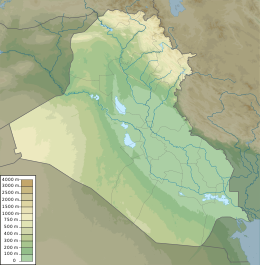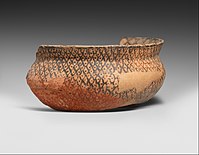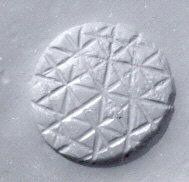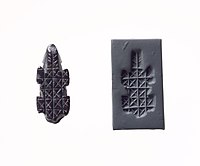Halaf culture

Halaf culture (in green), next to Samarra, Hassuna and Ubaid cultures. | |
| Geographical range | Mesopotamia |
|---|---|
| Period | Neolithic 3 – Pottery Neolithic (PN) |
| Dates | c. 6,100–5,100 BC |
| Type site | Tell Halaf |
| Major sites | Tell Brak |
| Preceded by | Pre-Pottery Neolithic B, Yarmukian culture |
| Followed by | Halaf-Ubaid Transitional period, Hassuna culture, Samarra culture |
| The Neolithic |
|---|
| ↑ Mesolithic |
| ↓ Chalcolithic |
The Halaf culture is a
While the period is named after the site of
The Halaf period was succeeded by the Halaf-Ubaid Transitional period, which comprised the late Halaf (c. 5400–5000 BC), and then by the Ubaid period.
Origin
Previously, the Syrian plains were not considered as the homeland of Halaf culture, and the Halafians were seen either as
Currently, eleven occupational layers have been unearthed in Sabi Abyad. Levels from 11 to 7 are considered pre-Halaf; from 6 to 4, transitional; and from 3 to 1, early Halaf. No hiatus in occupation is observed except between levels 11 and 10.[5] The new archaeology demonstrated that Halaf culture was not sudden and was not the result of foreign people, but rather a continuous process of indigenous cultural changes in northern Syria[7] that spread to the other regions.[1]
Culture
Architecture
Halaf pottery
Halaf pottery has been found in other parts of northern Mesopotamia, such as at Nineveh and Tepe Gawra, Chagar Bazar, Tell Amarna[8] and at many sites in Anatolia (Turkey) suggesting that it was widely used in the region.
-
Fragment of a bowl; 5600–5000 BC; ceramic; 8.2 cm; Metropolitan Museum of Art (New York City)
-
Halafian ware
-
Fertility figurine (maybe a goddess?); 5000–4000 BC; terracotta with traces of pigment; 8.1 × 5 × 5.4 cm; by Halaf culture; Walters Art Museum (Baltimore, US)
Stamp seals
The Halaf culture saw the earliest known appearance of stamp seals in the Near East.[9] They featured essentially geometric patterns.[9]
-
Loop-handled rectangular seal, Halaf culture.
-
Loop-handled circular seal.
-
Stamp seal and modern impression – geometric pattern. Halaf culture
Halaf's end (Northern Ubaid)
Halaf culture ended by 5000 BC after entering the so-called Halaf-Ubaid Transitional period.[10] Many Halafian settlements were abandoned, and the remaining ones showed Ubaidian characters.[11] The new period is named Northern Ubaid to distinguish it from the proper Ubaid in southern Mesopotamia,[12] and two explanations were presented for the transformation. The first maintains an invasion and a replacement of the Halafians by the Ubaidians; however, there is no hiatus between the Halaf and northern Ubaid which exclude the invasion theory.[11][13] The most plausible theory is a Halafian adoption of the Ubaid culture,[11] which is supported by most scholars, including Oates, Breniquet, and Akkermans.[12][13][14]
See also
References
Citations
- ^ ISBN 9781134750849.
- ^ Castro Gessner, G. 2011. "A Brief Overview of the Halaf Tradition" in Steadman, S and McMahon, G (eds.) The Oxford Handbook of Ancient anatolia. Oxford: Oxford University Press. p. 780
- ^ Castro Gessner, G. 2011. "A Brief Overview of the Halaf Tradition" in Steadman, S and McMahon, G (eds.) The Oxford Handbook of Ancient anatolia. Oxford: Oxford University Press. p. 781
- ^ Campbell, S. 2000. "The Burnt House at Arpachiyah: A Reexamination" Bulletin of the American Schools of Oriental Research no. 318. p. 1
- ^ a b Maria Grazia Masetti-Rouault; Olivier Rouault; M. Wafler (2000). La Djéziré et l'Euphrate syriens de la protohistoire à la fin du second millénaire av. J.C, Tendances dans l'interprétation historique des données nouvelles, (Subartu) – Chapter : Old and New Perspectives on the Origins of the Halaf Culture by Peter Akkermans. pp. 43–44.
- ISBN 9780521796668.
- ISBN 9780521796668.
- hdl:2268/102885.
- ^ ISBN 978-1614510352.
- ISBN 9780521871648.
- ^ ISBN 9780141938257.
- ^ ISBN 9781405137232.
- ^ ISBN 9780521796668.
- ISBN 9780826332547.
Bibliography
- Akkermans, Peter M.M.G.; Schwartz, Glenn M. (2003). The Archaeology of Syria: From Complex Hunter-Gatherers to Early Urban Societies (c. 16,000–300 BC). ISBN 978-0-52179-666-8.
- Liverani, Mario (2013). The Ancient Near East: History, Society and Economy. Routledge. ISBN 978-1-134-75091-7.
- Masetti-Rouault, Maria Grazia; Rouault, Olivier; Wafler, Markus (2000). La Djéziré et l'Euphrate syriens de la protohistoire à la fin du second millénaire av. J.C, Tendances dans l'interprétation historique des données nouvelles, (Subartu). ISBN 978-2-50351-063-7.
External links
- Halaf culture The Metropolitan Museum of Art
- Halaf Bowl from Arpachiyah - British Museum








